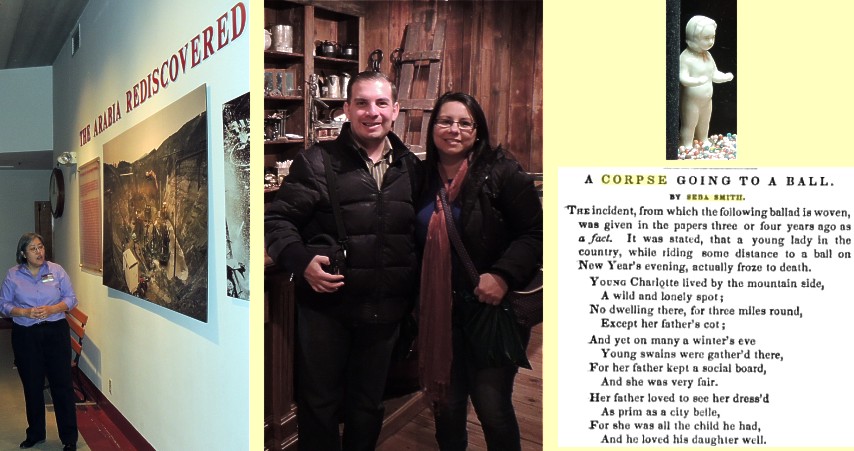Kansas Snapshots by Gloria Freeland - Jan. 24, 2014
Frozen Charlotte
The pretty young girl leaning over the railing couldn't have been more than 8. She looked back and forth between
husband Art and Sandra, the museum guide, as her finger pointed at something behind the glass case a short distance
away. Neither could make out what she was asking. It sounded like, "Is that Carl?"
Her face revealed both shyness and persistence as she attempted to make the two adults understand. She tried
spelling the key word, but it came out C-O-R- pause - L. Puzzled looks from both of them!
She reverted to saying the word very carefully and after several attempts, Art realized that the word she was
saying was "coral." She had been pointing at a white porcelain doorknob embedded in what had once been a jumble of
square nails, but time and water had reduced to a mass of rust. Sandra directed her around the corner where a half
dozen restored doorknob sets were on display.
Several years ago, I had visited the Steamboat Arabia museum in Kansas City and found it so fascinating that I
later returned with Art and, later still, with our daughters. This most recent visit was last weekend. We had arrived
in Kansas City the day before to pick up two visitors from Costa Rica. Carla and Johnny arrived near midnight, so we
spent the night in a motel. Knowing they had a busy two weeks ahead of them on the Kansas State University campus,
we decided Saturday would be devoted to some Kansas City sightseeing. We thought the museum would be interesting on
a day when high winds and cool temperatures made being outside not very pleasant for visitors from warm Central
America.
I enjoy museums, but for some reason, this one appeals to me more than most. It chronicles how on Sept. 5, 1856,
the 30-foot wide and half football-field-long paddlewheeler Arabia left Kansas City with 200 tons of cargo destined for
towns upstream along the Missouri River. But just a few miles into her journey, a sunken log punched a hole in the
hull and she sank. The water was so shallow that everyone got off safely. But the silty stream bed and cutting action
of the current swallowed up the ship overnight. In 1988, a group of locals uncovered it. They had intended to sell
the artifacts, but once they saw the cargo, decided a museum would be a more fitting tribute.
There is a snapshot aspect that provides a glimpse of what ordinary Americans on the frontier saw every day. Art
was surprised that the carpenters' and mechanics' tools would be completely familiar to anyone working in those
trades today.
What struck me most on this particular visit was a small white doll. Museum guide Sandra explained that the doll
was found carefully wrapped in a sock and stored in a tool box on the doomed Arabia. These dolls were popular in the
latter half of the 19th century and were commonly called "Frozen Charlotte" dolls. They ranged in size from just a
few inches to a foot or more in height. All were made with unbending joints of some hard material such as porcelain.
But while dolls have brought happiness to generations of children, the origin of the name for these dolls is not
quite what it may seem. In 1844, Volume 2 of a weekly booklet called "The Rover" was published. It was edited by
writer Seba Smith and was apparently a collection of materials, some old and some original. Page 209 contains Clement
Moore's "A Visit from Saint Nicholas" that we now know as "The Night before Christmas."
On page 225 is a poem, "A Corpse Going to a Ball," written by Smith. It's the tale of a young woman named Charlotte
who is picked up by her beau to attend a New Year's Eve dance in a village 15 miles away. The young woman did not want
her fancy dress rumpled by a heavy coat. So they left with her lightly dressed, despite her mother's warning to wear
more. When the couple's horse-drawn carriage arrived at the dance, her beau discovered Charlotte had frozen to death.
In a later version of the tale, her boyfriend Charlie returns with her body to her grief-stricken parents. He dies
soon after of sadness and the two are buried together.
In the introduction to the poem, Smith said it was inspired by an article he had read in the newspaper about just
such an event. The words in his poem were later set to music and the song is known as "Young Charlotte" or "Fair
Charlotte."
While there is no shortage of Internet references to this story, most are a jumbled tale of facts and fiction. But a
copy of "The Rover" from the Harvard Library substantiates the details stated above.
Each of my four trips through the artifacts of the Arabia has been like visiting a moment frozen in time. But as a
person who gets cold in the fall and never really warms again until spring, I think this visit and the tale of "Frozen
Charlotte" will stay with me for some time.
